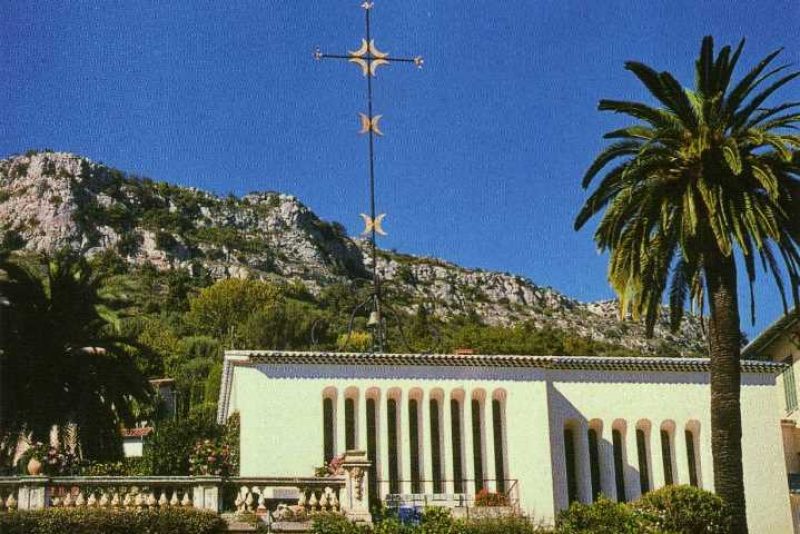Conor Power discovers the chapel in the South of France that is a Matisse masterpiece
The town of Vence in the South of France is a very short drive (about 20 minutes) from Nice International Airport. It enjoys an agreeable setting with the lower Alpine hills as a backdrop and the Mediterranean Sea within easy reach. Vence also benefits from the typical Riviera light that makes the atmosphere in this overcrowded part of the world so special.
The town itself doesn’t have a huge amount to recommend by way of beauty or interest – none more than the average town in France at least – and it exists in the shadow (both literally and figuratively) of its magical mediaeval neighbouring hilltop town of St Paul de Vence.
The main attraction in Vence, however, is the Chapelle du Rosaire – otherwise known as “Matisse’ Chapel” because it was was designed by the famous artist Henri Matisse.
Matisse died in 1954 at the age of 84 and was considered as a major rival to Picasso in the fauvist movement, which was all about simplicity and liberating the colours. The chapel is a unique piece of art/architecture as Matisse had a free hand not only in the colours and decoration of it, but also in the conception of the building itself and in the design of the pews and all the fittings and furnishings, as well as its famous stained-glass windows.
Matisse’ chapel, however, is the very antithesis of over-the-top gratification of praising the Almighty. Instead of the ornate and the overblown, you get a completely stripped-down version of a place of Catholic worship unlike anything you might have seen before.The unassuming entrance is off a very ordinary street and you would hardly suspect that such a treasure is present if it wasn’t for the familiar brown finger signposts telling you that this is the famous “Matisse’ Chapel”.
You go downstairs to the entrance, and even before you enter the chapel proper, you already have a feel for the
Spartan design that this particular place of worship involves.
My first reaction on seeing the chapel itself was to wonder if this was really it or whether this was just some large transit room that Matisse used to practice on that led you into the main masterpiece itself.
But no – this was it. The minimalist style of Matisse’ work looks like it’s all a bit unfinished and that it could be nicer if it was all painted out properly. I was missing the point completely, however. For Matisse, it was vital that this chapel was to be a place of peaceful reflection and prayer – not a bombastic show-piece of power but rather a place to power-down and think about how the world turned.
It takes a few minutes for the sense of peace and serenity to wash over you. Then you notice the light. The stained-glass windows feature calm blues, yellows and greens that play across the expanse of the chapel and its white walls all day long, as well as reflecting off the simple ceramic floor tiles.
There are no iconic-style paintings on the walls. Instead, simple sketch-like shapes adorn the walls. Matisse’ version of the Stations of the Cross, for example, is not the usual series of paintings positioned around the walls of the church, but one section of wall with the whole series portrayed in minimalist cryptic numbered sketches. His representations of patron St Dominic and the Madonna and Child are in the same style.
Although in ill health, Matisse spent four years (from 1948 to 1951) overseeing the creation of this chapel that he wished to bequeath as a gift to the Dominican Order of nuns in Vence. His depth of gratitude is all down to one nurse – Monique Bourgeois – who took great care of Matisse when he was recovering from a cancer diagnosed in 1941. She went on to join the Dominican Order in Vence (becoming Sister Jacques-Marie) and the chapel is as much a dedication to her as it is to the order itself.

Light, Peace and Serenity: Part of the interior of the Chapelle du Rosaire, depicting Madonna & Child
On the way out, you can also see an exhibition of the sketch-work and plans that were prepared by Matisse in advance. It gives you an insight into the level of sophisticated effort that he went through to come up with something so disarmingly simple.
I stepped out into the air of the Riviera at the end of the tour wondering what I had just seen. Was this a piece of art or a very different take on a place of worship? I suppose that you don’t need to be an artist to appreciate art and you don’t need to believe in God to appreciate a beautiful chapel. It turns out that Matisse was not religious at all. Or at least, that’s what he said, yet in his own words, this undoubtedly religious piece of work was his crowning glory:
“This work required me four years of an exclusive and all-consuming effort and it is the fruit of my whole working life. In spite of all its imperfections, I consider it as my masterpiece.”
Get Yourself There:
Aer Lingus (www.aerlingus.com) operate flights daily from Dublin and three times a week from Cork to Nice. The Chapelle du Rosaire (Chapel of the Rosary) is located at 466 Avenue Henri Matisse, Vence, France. Telephone: 0033.4.93.58.03.26
Where Exactly?





 Tootlafrance is Ireland’s fresh new eyes on France, bringing you the latest news, exclusive celebrity interviews, political analysis, cultural events, property news and, of course, travel features written by top Irish journalists.
Tootlafrance is Ireland’s fresh new eyes on France, bringing you the latest news, exclusive celebrity interviews, political analysis, cultural events, property news and, of course, travel features written by top Irish journalists.